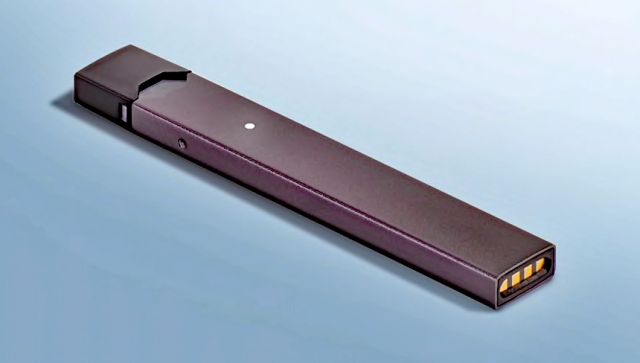Stopping the addiction: The Juul became too cool
Juul introduces reforms to combat underage use of their products
February 25, 2019
In several states, the minimum age to purchase a Juul device has been altered from 18+ to 21+. This change was made in response to youth vaping rates rising by 75 percent in 2018, as recorded by The Wall Street Journal.
Several states such as California, New Jersey, Massachusetts, Oregon, Hawaii and Maine have made this change, as well as localities including Washington D.C., New York City, Chicago, San Antonio, Boston, Cleveland and Minneapolis. Juul has also changed the age to purchase online from their website.
The Juul was originally created with the intention of use by adult smokers to aid them in the process of quitting cigarettes. Ironically, this market found itself becoming popular with young consumers. The attraction was fueled by several causes, such as the invention of fruity vape flavors like mango and cucumber.
Due to Juul’s small, discreet design that is usually scentless, it is easy for students to hide and use these devices regularly, even at school. This has become very problematic, and is largely found in FCPS schools.
“I Juul whenever, because I like the feeling I get from it,” an anonymous student at McLean said. “It is the only thing that releases my stress from school.”
A common misconception among teens is that Juuling is healthy because it does not have the same detrimental effects as cigarettes, such as tar. This may be true, however, one Juul pod is equivalent to smoking an entire pack of cigarettes.
“The addiction makes it so that for me, nicotine doesn’t have an effect anymore,” the anonymous student said. “I end up constantly searching for the feeling I used to get.”
The brand Juul is especially harmful, since the juice contains twice the amount of nicotine as other vapes. A study conducted by the Centers for Disease Control and Prevention showed that 63 percent of teens believed that Juul pods contained no nicotine. The reality is that 99 percent of these products contain this drug in high concentrations and can be even more harmful than cigarettes.
“I think teens in general see Juuling as an alternative to smoking,” junior Keanu Parker said. “Cigarettes are harder to reach than getting your hands on a Juul.”
With high amounts of teens becoming addicted to nicotine, Juul has set up the perfect industry to continuously make money, while destroying the health of an entire new generation.
“I’ve definitely seen how Juuling can affect my daily life and my mood,” the anonymous student said. “Sometimes, when I’m not Juuling, I find myself getting agitated quickly and it’s hard to concentrate on simple tasks.”
In response to furious parents, Juul has made various changes in the past few months to deter the underage use of their product, most significantly raisisng the minimum age requirement to purchase a Juul.
In November 2018, Juul announced that it would no longer be selling the fruit and candy flavored pods, and would only be continuing to produce the more traditional flavors, of mint and tobacco.
“[We] won’t tolerate a whole generation of young people becoming addicted to nicotine as a trade-off for enabling adults to have unfettered access to these same products,” Food and Drug Administration commissioner Scott Gottlieb said in a September 2018 statement.
This change was put in place in an attempt to deter teens from the Juul. By cutting out these flavors, Juul is expected to lose more than 45 percent of its usual profit, according to The New York Times.
As of Feb. 12, the Virginia General Assembly proposed a bill to raise the legal age to buy tobacco from 18+ to 21+. If this bill goes through, students will face difficulty scouring for Juul pods.
“Making it 21 to buy is great, but the age was 18 and kids are still getting them,” student resource officer Michael Davis said. “So only time will tell if making it 21 has a impact.”













